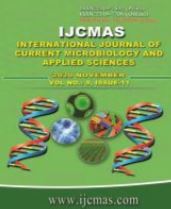


 National Academy of Agricultural Sciences (NAAS)
National Academy of Agricultural Sciences (NAAS)

|
PRINT ISSN : 2319-7692
Online ISSN : 2319-7706 Issues : 12 per year Publisher : Excellent Publishers Email : editorijcmas@gmail.com / submit@ijcmas.com Editor-in-chief: Dr.M.Prakash Index Copernicus ICV 2018: 95.39 NAAS RATING 2020: 5.38 |
The sapota fruit is very perishable cannot store longer than 5 days to rapid metabolic activities. Sapota fruit was reported massive post harvest losses and need mandatory to increase the shelf life of Sapota 20-30 days accordingly, there's a essential to control its ripening .. With none treatment, these could also be spoiled and to loss of water from fruit surface, faster respiration rate, attack of microorganisms, developing physiological disorders needed Modification of the atmosphere inside the package by lowering O2 concentration and increasing CO2 concentration depends on the characteristics of the produce and therefore the sort of the packaging film L-49 were wrapping using 9 μ LLDPE film result shown successfully stored up to 12 days at diffusive. And in evaporative cool chamber18 days with insignificant loss in vitamin C content 25–30% By applying T3 (shrink), the shelf life of fruit is increased for several time period at optimized temperatures (13-15°C) 75µLDPE (T2) proved to be the best treatments according to results revealed and followed by 100µLDPE (T3) also reported improve the quality standard and storability of fruits the 75µLDPE (T3 .As recorded in PP non-perforated The storage can increase upto 15 days and PP non-perforated (0.025 mm) was recorded as the most positive effect in physiological and maintain the chemical content like TSS and increase the shelf life for several days at rotating state using with 110C in 25 µ LDPE bags fruit was stored up to 35 days the treatment T3 (Shrink) showed result as compared to other treatments. In the T3 treatment, the shelf life of fruit increases to 18 days but in the other treatments the shelf life was only 15 days. The fruit without any treatments was edible around 6 days only. The minimum physiological loss in weight, decay loss and maximum pulp: peel ratio, fruit shape By applying T3 (shrink), enhance temperatures (13-15°C) the shelf life of fruit is increased for some time.
 |
 |
 |
 |
 |